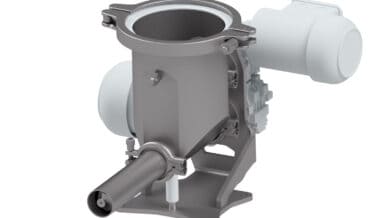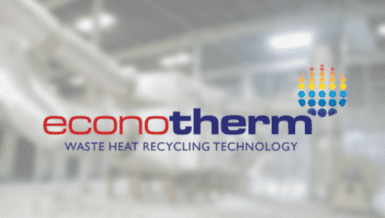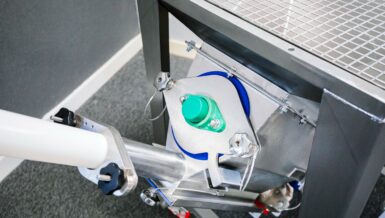Since 2000, Solex has introduced indirect heat transfer technology to the sugar industry with great success. The technology has been recognized as a proven and effective method for cooling sugar crystals before storage and packaging.
This type of indirect cooler has been successfully installed all over the world under different climate conditions in countries such as France, Germany, Portugal, the United States, Mexico, Poland, and Russia to name a few. The plants using Solex sugar cooling technology specialize in sugar beet plant, sugar cane plant, and starch and derivate sugar (Maltose, Sorbitol).
The Solex cooling unit can be installed either as a primary cooler or a secondary cooler and is readily adaptable to plant retrofits.
Equipment description
Solex indirect heat exchangers are a unique piece of equipment that consists of a bank of vertical, closely spaced, hollow, stainless steel plates. The sugar flows slowly by gravity between the plates in mass flow. Cooling water flows counter-current through the plates resulting in high thermal efficiency.
The cooling occurs by heat transfer through the sugar particles and is exclusively based on conduction. This cools the sugar indirectly and eliminates emissions and the need for fans, scrubbers, or other costly air-handling equipment. The sugar is not in contact with the air, eliminating the risk of introducing bad odors or microbiological contamination to the product.
At the bottom of the heat exchanger unit is a vibrating discharge feeder that creates mass flow and regulates the sugar throughput.
Solex technology is subject to patents and patent applications in various jurisdictions around the world.
Operational requirements at the Glinojeck sugar factory
The Polish Glinojeck sugar factory (Pfeifer & Langen Polska S.A.) operates both as a sugar beet plant as well as a refinery (outside of regular beet campaign), as such, the built-in flexibility of the sugar cooling step is of the utmost importance. The installation of a new sugar cooler at this facility was part of a large program aimed at refining raw sugar during the summer months while maintaining optimal quality of the product despite the higher temperatures outside.

To achieve optimum storage and packaging conditions for white crystal sugar, it was important to control the temperature of the sugar and to have a uniform temperature year-round. For this reason, the cooling unit was designed to operate under both summer and winter conditions. During the summer, the plant refines raw sugar and operates a syrup campaign. During winter they work exclusively with sugar beet. Thus, this plant is working for approximately three-quarters of the year.
For this plant, the ideal sugar storage temperature for the local ambient conditions is approximately 30°C.
Previous situation at the Glinkojeck sugar factory
Prior to implementing the Solex cooling unit, the plant used a fluid bed to cool their sugar. The main goal was to obtain the ideal storage temperature of the sugar in the summer. The cooling capacity of the existing system was not nearly sufficient.
The options available to the plant were to either install an air cooler which would result in significant energy consumption or to consider a technology that would be energy efficient as well as environmentally friendly while providing the required performance.
Goals for the investment
- Lowering final sugar temperature to the storage level (27-30oC) during the summer period.
- Lowering the electric energy usage through the elimination of the energy-consuming equipment.
Sugar drying room – status before modernization
- Two drum dryers with the production capacity of 55 t/d and 30 t/d with heating and dust cleaning systems
- Fluid bed cooler with air preparation and dust cleaning systems
Reconstruction
Disassembly of the fluid bed cooler with accompanying devices:
- Air blower
- Exhaust fan with a wet dust filter
- Removal of the transport conveyors
- Removal of sugar vibrating screens – 3 pieces
Assembly of the Solex cooler with accompanying devices:
- Frame and plate heat exchangers
- Water circulation pumps for cooler water system
- Installation of air cushion conveyor belts – two pieces
- Installation of the sugar bucket elevator after drum dryer
- Installation of the vibrating screen before the Solex cooler
Assumptions considered for the project
Sugar parameters
- Inlet Temperature – 55oC
- Outlet Temper
- Flow – 65 t / h
- ature – 30oC
- Ma – 630 µm
- CV – 30
- Density – 880 kg/m3
Water cooler parameters
- Flow – 72 m3/h
- Inlet Temperature – 20oC
- Outlet Temperature – 27oC
- Pressure drop – 0.3 bar
- Water cooled with cooling tower
Operation and maintenance
The operation of the vertical cooler is completely automated, with the unit’s Level and Temperature Control System integrated into the plant’s Distributed Control System (DCS).

The maintenance of the equipment consists of washing the interior of the exchanger at the end of the campaign. This operation is extremely easy as large doors allow for access to the plate banks. Both the inlet hopper and the vibrating discharge feeder are also equipped with inspection and maintenance openings.
Power consumption in kW / 65 tons of sugar
Before modernization (fluid bed)
| No. | Unit name | Power in kW | Load factor | Load in kW |
| 1 | Lump screen after big dryer | 7 | 0.70 | 4.9 |
| 2 | Conveyor belt No. 1 after big dryer | 4 | 0.70 | 2.8 |
| 3 | Conveyor belt No. 2 after big dryer | 4 | 0.70 | 2.8 |
| 4 | Conveyor belt No. 3 after big dryer | 4 | 0.70 | 2.8 |
| 5 | Lump screen after small dryer | 4 | 0.70 | 2.8 |
| 6 | Conveyor belt after small dryer | 4 | 0.70 | 2.8 |
| 7 | Fluid bed cooler fan | 132 | 0.65 | 85.8 |
| 8 | Scrubber exhaust fan | 90 | 0.60 | 54 |
| 9 | Valve drive for fluid bed cooler inlet air | 0.25 | 0.70 | 0.175 |
| 10 | Valve drive for fluid bed cooler outlet air | 0.25 | 0.70 | 0.175 |
| 11 | Valve drive for scrubber inlet air | 0.25 | 0.70 | 0.175 |
| TOTAL | 159.225 |
After modernization (vertical plate exchanger)
| No. | Unit name | Power in kW | Load factor | Load in kW |
| 1 | Air-cushioned belt conveyor after small dryer | 4.5 | 0.70 | 3.15 |
| 2 | Air-cushioned belt conveyor fan after small dryer | 4 | 0.70 | 2.8 |
| 3 | Air conveyor | 4.5 | 0.70 | 3.15 |
| 4 | Air-cushioned belt conveyor fan after big dryer | 4 | 0.70 | 2.8 |
| 5 | Bucket elevator | 9.2 | 0.70 | 6.44 |
| 6 | Lump screen | 4 | 0.70 | 2.8 |
| 7 | Sugar cooler | 4 | 0.70 | 2.8 |
| 8 | Air conveyor | 9.2 | 0.70 | 6.44 |
| 9 | Air conveyor fan | 4 | 0.70 | 2.8 |
| 10 | Cooler water pump | 7.5 | 0.70 | 5.25 |
| TOTAL | 38.43 |
Power consumption in kW per ton of sugar
- Before modernization: ~2.5 kW / ton of sugar
- After modernization: – ~ 0.6 kW / ton of sugar
Conclusion
The Glinojeck sugar factory found that integrating the Solex sugar cooling unit uses significantly less energy than traditional technologies, with no air handling equipment. The end product resulted in sugar with a stable temperature for storage, regardless of ambient weather conditions.
The vertical orientation of the unit allowed it to take up far less space within the facility. With no moving parts, there is also a significant decrease in maintenance required.











































